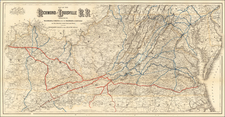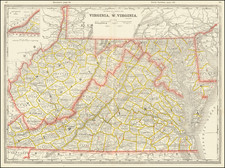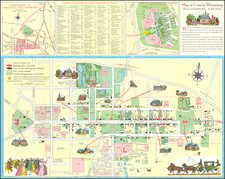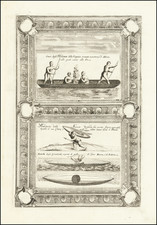Mathew Carey's map of Virginia, was first published in 1796 in Philadelphia and included in Carey's American Pocket Atlas.
This miniature map, though small in scale, comprehensively illustrates the geography of Virginia, marking towns, roads, rivers, mountains, and various other features that provide an intricate portrayal of the state during this period.
The late 18th century was a significant time for the Commonwealth of Virginia, with the aftermath of the American Revolutionary War and the ongoing establishment of the new nation's governmental structure. Virginia played a crucial role as one of the original thirteen states and the birthplace of several influential Founding Fathers. Carey's map, therefore, not only serves as a geographical representation but also as a historical snapshot of Virginia's position in early American history.
Mathew Carey's work in cartography represents part of a larger movement in the United States towards domestic map production and a growing sense of national identity. This particular map of Virginia showcases a high level of detail and precision that would have been vital for travelers, policymakers, and scholars of the era. Its inclusion in Carey's American Pocket Atlas emphasizes the importance of accessible and portable geographical knowledge during a time of expanding frontiers and internal development.
The map also reflects the technological and artistic advancements in cartography during the period. The ability to condense such intricate details into a miniature format is a testament to Carey's skill and the evolving techniques of engraving and printing in America. Despite its compact size, the map retains clarity and provides a thorough depiction of Virginia's topographical and human-made features.
In conclusion, Mathew Carey's 1796 map of Virginia is a remarkable piece that blends geographical accuracy with historical context. It serves as an example of the burgeoning American cartographic tradition and provides a window into the landscape and significance of Virginia at the close of the 18th century. It holds value not merely as a navigational tool but as a document that encapsulates a moment in the nation's history and the artistry of its depiction.
States of The Map
The map is known in three states:
- State 1 (1796): Washington shown.
- State 2: (1801): Boundaries of District of Columbia added, but no border. Many other changes, including Wheeling and Fishing C. on the Ohio River.
- State 3: (1805) Terry. of Columbia added, Washington is now Washington City, along with border around the District of Columbia. Many other changes, including Vienna, and P. Pleasant on the Ohio River.











![[Shows Franklinia!] Charte Der XV Vereinigten Staaten von Nord-America Nach Murdochischer Projection . . . F.G. Gussefeld . . . 1804](https://storage.googleapis.com/raremaps/img/small/91386.jpg)

![[ Yorktown ] Plan of the Siege of York Town in Virginia . . .](https://storage.googleapis.com/raremaps/img/small/102061.jpg)
